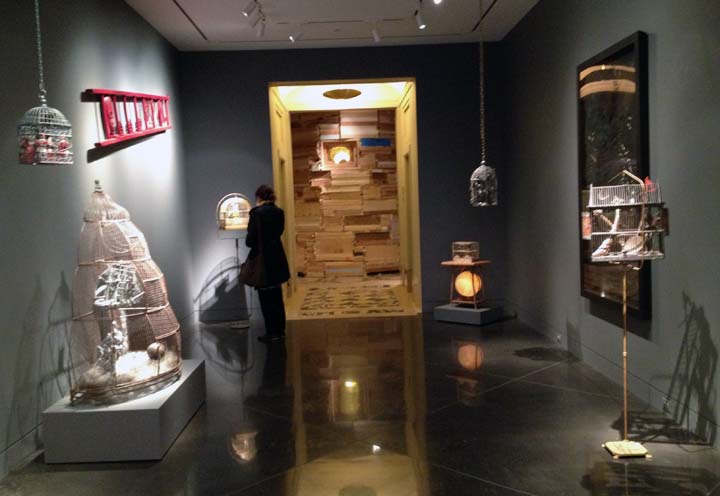Seismic Shifts at the National Academy
Seismic Shift: Ten Visionaries in Contemporary Art and Architecture opened Friday at the National Academy Museum. “Visionaries,” as defined during a walkthrough last Wednesday with curator Marshall N. Price, are people whose innovative thinking and practice have shifted the dialogue, in this case, on the arts. The exhibition features works by Nick Cave, Thornton Dial, Tom Friedman, Vik Muniz, Wangechi Mutu, BetyeSaar, and Bill Viola, and recent projects by architects Greg Lynn, Kate Orff, and Moshe Safdie.
Entering the main floor of the museum, one arrives in a temple-like installation of pieces by West Coast artist Betye Saar (b. 1926), mainly from her “Cages” series (photo below). Whimsical on first impression, these objects made from discarded materials reveal the artist’s deeply grounded concerns with mysticism, fetishism, and diaristic evocations of the African-American experience.
In Rhythm and Blues (2012), a tin toy black Sambo figure is trapped in a golden birdcage. For Serving Time (2010), Saar festoons another birdcage with bunches of corroded keys attached with chains and padlocks. With Red Ascension (2011), a wooden ladder supports an African mask, three miniature sailing ships, a man in the moon figure, a dagger, and more chains. Painted overall in red, this exuberant assemblage evokes colonialism, the triangle trade route and slavery. Hope, loss, and trauma combine to uplift while invoking a shameful past, in combining the material and the metaphysical.

The exhibition continues in the second floor galleries, with a major installation of Kate Orff’s (b. 1971) Oyster-tecture project, which envisions the cleanup of the highly toxic Gowanus Canal as a site for oyster farming combined with water sports and quiet recreation. Orff’s work is distinguished by a nearly simplistic practicality that would make her high-concept ideas buildable. While her plans are based on low-impact restorative landscape design, the presentations, including the large model of Oyster-tecture, are executed at the height of high-tech wonder.
Across the room is an installation of Nick Cave’s (b.1959) Sound Suits, including one made of wildly colorful human hair. Cave, who once performed with the Alvin Ailey Dance Company, changes and supercharges the conversation about personification, performance, and art in these creations, which completely obliterate the wearer's identity, except for the feet. [video]
In the next gallery are three pieces by Thornton Dial (b. 1928), whose work is having something of a re-investigation this year. The son of sharecroppers, Dial worked in the fields as soon as he could walk. He worked most of his adult life as a welder, but in his spare time, he made things in a shed in his backyard. On retiring, he began creating pieces combining discarded materials, over-painted in a way that blurs the distinction between assemblage and painting, between abstraction and representation. Dial’s art is prized for its originality, its emotional impact and its acute commentary on the experience of an African-American from the South whose lifetime encompasses the brutal Jim Crow years and the burgeoning civil-rights movement.
In addition, photographs by Vik Muniz (b.1961) celebrate the catadores of Brazil, pickers of recyclable materials at the largest garbage dump in the world. Affecting social change and encouraging people to rethink existing societal norms, Muniz creates portraits of catadores that are inspired by classical paintings and assembled from the very materials they spend their days gathering. Kenyan-born artist Wangechi Mutu (b. 1972)creates through the prism of globalism, feminism, cultural identity and post-colonialism, making complex collages of female figures, such as A Dragon Kiss Always Ends in Ashes (2007), depicting a nude figure entangled with a serpentine dragon.
Seen together, the work of the seven artists and three architects presented in Seismic Shifts offers a thought-provoking and exhilarating view of art today.
Seismic Shift: Ten Visionaries in Contemporary Art and Architecture continues through May 5th at the National Academy Museum. 1083 Fifth Avenue, at 89th Street, NY, NY. Public programs include:
Wednesday, February 27, 2013, 6:30-8:00 PM
Art, Politics, Protest: Dr. Cornel West and Faith Ringgold in Conversation
moderated by Dr. Leslie King-Hammond.
Friday, March 15, 2013, 3:00-4:00 PM
Curator Insights: Seismic Shifts
Gallery tour with Curator of Modern and
Contemporary Art Dr. Marshall N. Price
Wednesday, April 17, 2013,6:30-8:00 PM
Thornton Dial: His Work, His Legacy and the Notion of "Outsider" Art
Artist David
C. Driskell and cultural critic and scholar Greg Tate discuss Dial's work and legacy, following a screening of a brief documentary on the life and work of this Alabama artist.
Photo; Peggy Roalf


